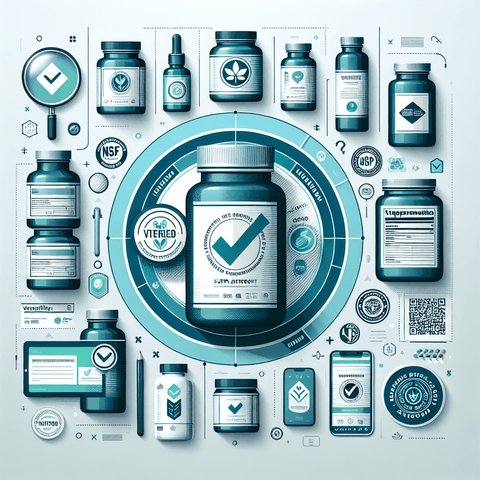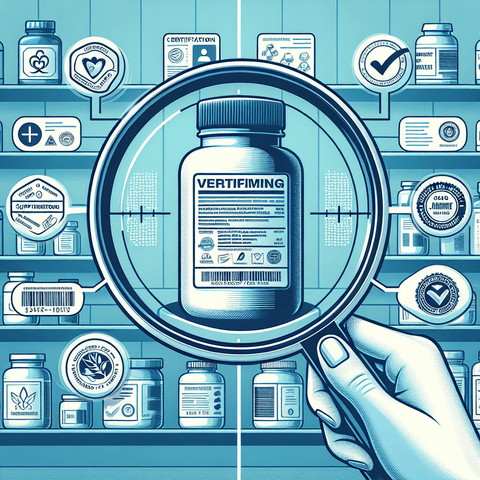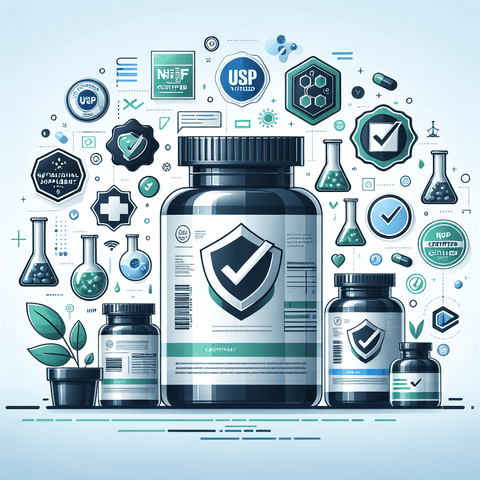Introduction
In recent years, nutritional supplements have experienced an exponential rise in popularity among consumers seeking to optimize their health, enhance athletic performance, or support specific wellness goals. From vitamin capsules to herbal extracts and minerals, the variety of available supplements is vast, making them a staple in many households. However, this surge in demand has inevitably led to challenges surrounding product authenticity, label accuracy, and consumer safety.
Understanding supplement labels is crucial. Not only do labels inform consumers about what they are consuming, but they also serve as a critical component in ensuring safety and efficacy. Misleading claims, mislabeling, presence of counterfeit products, and deceptive marketing tactics have become prevalent concerns for consumers trying to make informed decisions. Given the complex regulatory landscape—where agencies like the FDA, FTC, and the Dietary Supplement Health and Education Act (DSHEA) establish standards—it can be difficult for average buyers to navigate what is trustworthy and what is potentially harmful.
This comprehensive article aims to demystify the language of supplement labels, teach you how to verify authenticity, recognize misleading claims, and spot fake products. With consumers playing a vital role in safeguarding their health by becoming informed, this guide provides expert tips to help you decode supplement claims and avoid counterfeit products, ultimately empowering you to make safe, informed choices.
Supplement Label Claims: What Do They Really Mean?
Supplements often come with a plethora of claims designed to persuade consumers of their benefits. Terms such as “high potency,” “all-natural,” “gluten-free,” “clinically proven,” or “boosts immunity” are common on labels. While some of these statements are regulated and backed by evidence, others can be vague, exaggerated, or outright misleading.
Understanding what these claims imply requires awareness of how regulations intersect with marketing. In the United States, the FDA oversees supplement labeling but does not approve health claims before products reach the market. Instead, the Dietary Supplement Health and Education Act (DSHEA) sets standards, requiring supplement labels to be truthful and not misleading. The Federal Trade Commission (FTC) regulates advertising claims, ensuring they are substantiated by science when they imply health benefits. However, companies can use implied claims—statements that suggest benefits without explicitly claiming a disease cure—which often skirt closer to regulation boundaries.
Common claims like “high potency” suggest a higher dose of active ingredients, but without precise ingredient amounts listed, consumers cannot verify these assertions. Terms such as “all-natural” may appear reassuring but lack specific regulatory definitions. For example, what qualifies as “natural” is often subjective, and some products labeled as such still contain synthetic preservatives or fillers.
Claims like “clinically proven” are particularly persuasive, but they need to be scrutinized. Often, such language references small or poorly designed studies that have little real-world applicability. Misleading claims can lead consumers to believe a supplement will deliver promised effects, which might not be supported by substantial scientific evidence—posing risks to health and trust.
Misleading or unsubstantiated claims influence consumer perceptions significantly, sometimes leading to overconsumption or reliance on ineffective products. This can delay seeking appropriate medical advice, result in adverse interactions with medications, or present unnecessary financial costs. Thus, being able to critically assess these claims is fundamental to making educated choices and avoiding disappointment or harm.
supplement Transparency: Why Full Disclosure Matters
Transparency in supplement labeling refers to the extent to which manufacturers openly disclose ingredient sources, manufacturing practices, batch information, and potential contaminants. Transparent companies prioritize honest communication, enabling consumers to make informed decisions and fostering trust. Conversely, opaque brands often conceal critical information, increasing risks related to safety and efficacy.
Full disclosure typically includes detailed ingredient lists with specific dosages, information about sourcing and processing, and quality assurance procedures. For example, a reputable supplement company might specify that their vitamin D is sourced from cholecalciferol derived from lanolin or lichen, providing clarity about origin. Transparent brands also disclose testing results for contaminants like heavy metals, microbes, or pesticides, often available via third-party lab reports.
In today’s market, transparency builds consumer confidence. Companies that openly share their manufacturing processes and third-party testing results demonstrate a commitment to quality. A case in point is supplement brands that collaborate with third-party organizations like NSF, USP, or ConsumerLab, which verify product contents and safety. Visiting their official websites or checking QR codes often reveals batch-specific data, reinforcing trustworthiness.
Case studies show that brands emphasizing transparency tend to have fewer quality issues and fewer reports of adverse effects. For instance, a supplement line that publishes comprehensive sourcing and testing data can help consumers avoid products contaminated with heavy metals or misrepresented ingredients. Transparency not only enhances safety but also ensures the product's efficacy, as consumers can verify that they are receiving the expected dose of active compounds.
When selecting supplements, look for labels that provide detailed ingredient disclosures, third-party testing seals, and clear manufacturing information. This proactive approach is key to avoiding ineffective or dangerous products. Remember, a truly transparent supplement respects regulatory standards and openly shares information regarding its sourcing, production, and testing processes—making it a safer choice for your health.
Label Authenticity Verification: Ensuring You Get What You Paid For
Authenticity verification is essential to safeguard against counterfeit or tampered supplement products. As counterfeit supplements become more sophisticated, consumers must employ multiple strategies to authenticate labels and packaging before purchase and consumption.
Firstly, scrutinize the entire label and packaging. Look for signs of tampering, such as broken seals, inconsistent printing, spelling errors, or poorly printed labels. Authentic products typically have high-quality packaging, uniform fonts, and clear holograms or holographic seals that are difficult to replicate. Many reputable brands incorporate QR codes, security holograms, or serial numbers that can be scanned or verified online using official verification portals, often found at the manufacturer's website or third-party testing entities.
Another helpful practice is to purchase supplements from reputable sources—official brand websites, authorized distributors, or well-known retailers—reducing the risk of counterfeit products. Avoid deals that seem too good to be true or products sold through suspicious third-party vendors. Cross-referencing product details with official databases, such as those maintained by third-party organizations (e.g., NSF or USP), is a critical step. These organizations verify whether a product is registered or tested and often provide online tools for verification.
Many modern packaging features include holograms and holographic seals that change appearance when viewed at different angles. These features are difficult to counterfeit and should be checked thoroughly. Additionally, using smartphone apps or online tools designed for supplement verification can help confirm authenticity. Some brands also provide customer service hotlines or support channels where consumers can verify product details with representatives.
Tools and apps such as barcode scanners and verification platforms are increasingly available, enabling consumers to cross-reference batch numbers or QR codes quickly. By combining visual inspection with technological verification methods, consumers can significantly reduce the risk of unknowingly purchasing counterfeit or adulterated supplements.
Ultimately, purchasing from trusted sources and verifying authenticity through multiple channels helps ensure you get exactly what you paid for and that the product is safe and effective for your needs.
Ingredient Mislabeling: The Hidden Risk in Many Supplements
Ingredient mislabeling remains one of the most serious concerns in the supplement industry. It involves inaccuracies where ingredients are added, omitted, or misrepresented intentionally or unintentionally, posing health risks and undermining consumer trust.
Common instances include supplements claiming to contain exotic herbs or superfoods that are absent, or products mistakenly listing ingredients in incorrect amounts. Sometimes, manufacturers add unauthorized fillers or contaminants to reduce costs, while others may miss to include ingredients that are actually present—either because of poor manufacturing practices or deliberate deception. The consequences of ingredient mislabeling can be severe, particularly for consumers with allergies, sensitivities, or specific health conditions.
To spot mislabeling, consumers should compare the ingredients list with third-party tested results or certificates of analysis (COAs). For example, reputable brands like those in the vitamin or omega-3 category disclose detailed component analyses indicating the actual concentration of active ingredients. Compare the declared serving size and potency with independent testing reports to detect discrepancies.
False claims about “all-natural” or “exotic” ingredients are red flags. For instance, a supplement claiming to contain “100% pure Himalayan herbs” but lacking transparent sourcing information could be suspect. Discrepancies in the listed and actual ingredient quantities, or the presence of unlisted substances, are often indicators of mislabeling.
Health risks linked to ingredient mislabeling include allergic reactions, drug interactions, toxicity, or the administration of ineffective compounds. Consumers must therefore remain vigilant, especially when purchasing from unfamiliar brands or online sellers. Ensuring the supplement has undergone third-party testing can mitigate some risks but maintaining skepticism and cross-referencing labels remains essential.
supplement Fraud Detection: Recognizing and Avoiding Counterfeit Products
Counterfeit and spiked supplement products represent a significant threat to consumer health and industry credibility. These products are often produced in unregulated settings, with false labeling, incorrect ingredients, or contaminated contents. Being aware of their telltale signs is critical to avoid potentially dangerous products.
Counterfeit supplements often feature poor packaging quality, spelling errors, mismatched logos, or inconsistent font styles. They may have unusual smells, tastes, or textures. Sometimes, the batch number or hologram is missing or appears to be altered. The packaging may look similar to authentic products but lacks the detailed manufacturing information or official verification seals.
To detect fraudulent products, start by buying only from trusted sources—official websites, authorized retailers, or certified pharmacies. Be skeptical of online listings offering heavily discounted products or those that are not sold through reputable channels. Consult consumer reviews and reports to identify recurrent issues or complaints about counterfeit items.
Third-party verification organizations play a crucial role—they test and certify products for potency, purity, and safety. Look for badges or seals from organizations like NSF, USP, or ConsumerLab, which indicate that the product has undergone thorough testing. When in doubt, contacting the manufacturer for verification or batch-specific COAs adds an extra layer of security.
Regularly reporting suspected counterfeit products to regulatory authorities can help authorities trace and shut down illegal manufacturing sites. Using verification apps, checking packaging for holograms, and scrutinizing product details help consumers confidently distinguish between authentic and fake products.
Precaution, skepticism, and verification tools are your best defenses against supplement fraud. Protect yourself by only purchasing from verified sources that adhere to industry standards and quality controls, ensuring your health remains safeguarded.
Truthful Product Representation: Building Consumer Confidence
Truthful product representation is fundamental for building consumer trust and ensuring public health. Ethical marketing practices, transparent labeling, and rigorous quality standards demonstrate a brand’s commitment to consumer safety and integrity.
Regulatory bodies like the FDA enforce rules requiring truthful label disclosures, but enforcement often relies on surveillance and consumer reports. Many reputable companies voluntarily undergo third-party audits, submit their products for independent testing, and publish results openly. Such practices not only comply with regulations but also foster confidence among consumers who can verify product claims against independent data.
Marketing tactics that deceive consumers include exaggerated claims, before-and-after images, and ambiguous language designed to suggest benefits that are not scientifically substantiated. Knowing how to recognize these tactics—such as overly aggressive language or unsubstantiated health claims—helps consumers avoid falling prey to false advertising.
To differentiate between truthful and deceptive marketing, look for clear, transparent information on labels, comprehensive third-party verification seals, and accessible safety data. Educating oneself about the difference can prevent misleading purchases and reduce the risk of harm.
Encouraging brands to adopt ethical marketing and transparent labeling not only protects consumers but also elevates industry standards overall. Support for legislation enforcing stricter labeling rules and for third-party certifications enhances trust and safety across the supplement industry.
Practical Tips for Consumers to Protect Themselves
Being an empowered consumer involves diligent label reading, verification, and consultation. Here are practical steps to protect yourself:
- Read labels thoroughly: Check ingredient lists, serving sizes, expiration dates, batch numbers, and certifications.
- Recognize red flags: Look for spelling errors, poorly printed labels, holograms that don’t change, or packaging inconsistencies.
- Verify authenticity: Use QR codes, official verification apps, and cross-reference with trusted databases like NSF or USP.
- Research brands: Prefer companies with transparent sourcing, third-party testing, and positive reputations.
- Consult healthcare professionals: Always seek advice from qualified practitioners before starting new supplements, especially if you have existing health conditions or take medications.
- Use trusted sources: Purchase from reputable stores, official websites, or certified online sellers.
- Report suspicious products: Notify regulatory agencies if you encounter counterfeit or misrepresented supplements.
Staying vigilant and using available verification tools empower consumers to make safe choices, protect their health, and avoid wasting money on ineffective or hazardous products.
Conclusion
In summary, navigating the world of nutritional supplements requires acute awareness of label claims, a commitment to verifying authenticity, and vigilance against mislabeling and fraud. Understanding the regulatory environment and tools available can help you identify genuine products and avoid counterfeit or misleading items. Transparency and ethical practices in the industry foster consumer trust, but ultimately, individual vigilance remains the most effective safeguard.
As consumers, you have the power to influence industry standards through informed purchasing decisions and reporting suspicious products. Prioritize safety, choose reputable brands, and always seek professional guidance when incorporating new supplements into your health regimen. By staying informed and discerning, you can ensure that your supplement choices support your health goals without compromising safety.
Q&A Section
Q1: How can I tell if a supplement claim is truthful?
A truthful claim is supported by scientific evidence, verified by third-party organizations, and consistent with regulatory standards. Look for certification seals like NSF or USP and avoid products with exaggerated or vague claims.
Q2: What are some red flags indicating a counterfeit supplement?
Poor packaging quality, spelling errors, missing holograms, unusual taste or smell, and suspicious pricing are all red flags. Always purchase from trusted sources and verify via official portals or verification apps.
Q3: Why is transparency in sourcing important?
Transparency ensures you know where ingredients come from, how they are processed, and whether quality controls are in place—crucial factors in safety and efficacy.
Q4: How do I recognize fake supplement products?
Fake products often have inconsistent packaging, lack of official seals, or missing batch-specific information. Use verification tools, check for holograms, and buy only from authorized vendors.
Q5: How can I protect myself from ingredient mislabeling?
Compare the label with third-party testing results, look for clear and detailed ingredient lists, and verify sources. Avoid products with vague labeling or unverified claims.
Important Keywords
- Supplement label claims
- Decoding supplement labels
- Fake supplement products
- Supplement authenticity verification
- Supplement mislabeling
- Counterfeit supplements
- Third-party testing
- Transparent supplement brands
- Supplement fraud detection
- Health safety in supplements
- Reliable supplement sources
- Regulatory standards
- Supplement industry regulation



